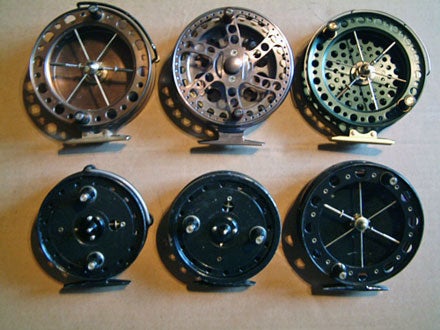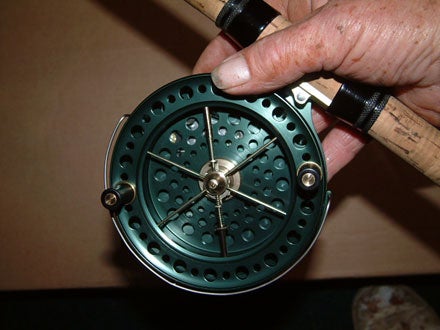All about centrepin reels, or ‘pins, as we fondly call themI hear a lot from new and old FM members as to should they purchase a ‘pin or not and also there main uses. Are they as good as a fixed spool reel, and where should I use them and in what conditions.Well I believe that a ‘pin in the right hands is every bit as good, if not better, than a fixed spool reel any day of the week. And certainly much more fun. In the picture you will see a selection of ‘pins I own , these range from true ‘pins from the 60’s to present day ‘pins with bearings. Some 3.5 inches and some 4.5 inches. I own six because, well I just like ‘pins for a start, some appeal to me more than others, but they will all do the same job at the end of the day. Why six? Because it gives me a choice of lines from 2 lb up to 8 lb. I could buy spare spools but this would cost nearly as much as the reel itself. So I just buy a different reel. And sometimes I buy them just because they look pretty. Some have line guards and some don’t, some are removable and some are fixed. Whatever you want in a reel it is there for the taking at the end of the day it’s your choice. But do look carefully before you buy and choose a reel that suits you. The ones in the picture range in price from £ 60 to £ 275. UsesWhat type of fishing do I do with a centrepin? Any kind of fishing you want . Centrepins were invented long , long before any fixed spool reel. The only reason fixed spool reels were invented was to make life easier for casting. As fishing grew there became a need to cast long distances and this became quite hard with a centrepin . And so the fixed spool was born. And very fine too. But you can still do most things with a ‘pin if you put your mind to it. And I think it is every bit worth the effort. And effort is what you are going to have to put in to get the best from yours. Mostly any kind of float fishing is possible. Trotting is most common. Using a stick float to trot, laying on, stretpegging and even legering is possible. And freelining for barbel is a classic. There are a few times when you won’t want to use a ‘pin, such as on very windy days. But even that’s possible if fishing close to hand with a line guard fitted.
Loading a pin with lineI have had lots of different people tell me lots of different ways of loading a ‘pin. Some say put only 25 yds of line on, others recommend 50 yds on, and that you should keep the line all to one side.Well, for me, I put around 40 yds as I rarely trot a float any further. I just can’t see it any further away. As for how I load it on, well I just wind it on any old how. For the simple reason that no matter how I wind it on, after the first trot down of say 30 yds most of the line has come off the reel and all I do is wind it back on for the next cast. But doing this I don’t stand there and make sure it’s all going on one side or criss-cross pattern I just want to get line back on the reel for the next cast and it goes as it goes. So what’s the point in taking all that care in the first place? What I will say is that if you overload the reel and put too much line on, it will bed in and make trotting more difficult as the line won’t pay out so easily. And also a point to mention is that after catching a big fish the line will almost certainly bed in, so you may have to for the first trot down pay out the line with your hands rather than just allowing the spool to revolve simply from the pull of the river. Next cast you’ll be back to easy street.
OilingThere has been a recent thread on the forum that discussed, amongst other things, oiling centrepin reels and what type of oil should be used. Well, I have changed my mind somewhat in what oil I use. I have always used Johnson’s Baby Oil in the past with great results, but due to this thread I now use what I consider to be the best and that is sewing machine oil. Of course there are oils sold for ‘pins but they are more expensive. As to should I oil it or not , then I would say yes, certainly you should . All moving metal parts need oil to run smoothly and prevent wear.Using a pinWell I can’t teach to this. This is something that you only get from putting in time and effort.What I will say is, if you have a friend that is experienced with using a ‘pin, then get him or her to take you out and get you started. There are pro’s that give lessons. Or you can do what I did when I first started (struggled more like!) and picked it up as I went along.
I have added a picture here just to show how I hold a pin. This position gives me total control with my thumb, My thumb is used to brake the spool, it’s my clutch when playing fish, and it pays out line when trotting. My thumb is my control button and without this the ‘pin is useless. My advice to anyone would be to watch some video’s of people such as John Wilson and other experts centrepin users. Take note of how they use a ‘pin, how they cast long or short. How they trot a float, retrieve line and such. It does take time, so don’t go out and buy a ‘pin and think it’s easy, cos it ain’t. But after you master the essentials you’ll know what fishing is all about. You’ll probably find that on your first outing you will suffer overruns or birds’ nests, tangles and the like, but don’t let these things put you off. Centrepin users have all been there and done that and bought the tee shirt, so don’t worry if at first it all goes wrong. Just keep trying for a while and you’ll find that it will all come together. When you first get your ‘pin and you’ve loaded it with line and a large float with plenty of shot on it, find a place where you can practice, a field or even your garden; anywhere with some space. Practice short casts, what we call finger casting , where you just get your finger of your left hand just in front of the first eye of the rod and pull off line until your left arm is as far to the left as possible , do this with the ratchet on to start with, for this way you will not suffer from overruns. Until, that is, your right thumb gets together with your brain and is in control. Both your hands have to work together in all cases when using a pin. And this only comes with practice. When you’re pulling line from the reel your thumb wants to be resting lightly on the reel with just enough pressure to stop the reel flying away with you. Now take your rod and your left arm round to the left in a nice easy action and then throw the float out with a sweeping motion, pointing the rod at the target area and releasing the line at the same time. If you have it weighted correctly it should land where you aimed it. On most ‘pins there is a clutch just like a fixed spool reel. On the front of the reel there is a little round wheel which you can rotate and put a tiny amount of pressure on the spool to slow it down. This is useful, for instance, when fishing in very fast flowing water. Myself though, I never use it, preferring to just use my thumb, but it does help when learning, or when fishing close in. It can stop most of those unwanted birds’ nests. Many anglers, when they get their first ‘pin, try to cast out a small, very light float and expect it to go a long way. This is not going to happen. And that’s why they end up in so many tangles and birds’ nests. Like waggler fishing, to cast any distance you need weight. It is this weight that gives the momentum to pull line through the eyes of the rod. If there is no pull then the float goes nowhere and the line just keeps running off the reel. But if you add a nice chunky float and plenty of weight, that weight will pull the line off as fast as the reel is spinning. This applies to the Wallis cast of course. But really I could go on and on trying to get across this message, when all you really need is to get out with your ‘pin and learn mostly from doing it. So many people have different ideas on what and what not to do and I do things my way as you should do yours. I am really no expert and won’t pretend to be one. I still have a great deal to learn about ‘pins and am learning all the time, but what I do know about them I am just trying to share with you. I dare say that this article will bring a great deal of discussion. It is not written to teach you in any way how to fish with a ‘pin. It is merely an insight to get you started. And I have only touched the surface of fishing with ‘pins. What I will say is that when you first go out with your ‘pin it may go well, and it may not. Don’t be put off if it doesn’t go well and those around you snigger and make fun when they see you all in a tangle. Don’t worry about people like this because people that behave like this are not people at all and are not worth knowing. The people that offer advice and a kind word, or simply just mind their own business and carry on and let you get on with it are true fishermen and women. I hope this has given food for thought and all those contemplating going out to buy a ‘pin will benefit from this article and will encourage more people to try centrepin fishing. It is a lovely way to spend a day. |
Welcome!Log into your account












